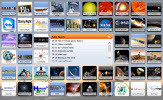July 2019
This month the visible planets are in a 'state of flux'. Both inner planets disappear in the Sun's glare as one, Mercury moves toward inferior conjunction, while the other, Venus, moves toward supeior conjunction. Mars is slowly growing dimmer and is steadily moving closer to the Sun and becoming a challenge to see around sunset. Fortunately two of the giant outer planets, Jupiter and Saturn, remain visible throughout the night hours.
Dwarf Planet Ceres remains close to Jupiter and the reddish star Antares this month but with an apparent magnitude of 7-8 Ceres will only be visible with optical assistance or with time exposure pictures.
Click here for the month at a glance calendar.

Mercury is low over the western horizon at sunset local time and by the 21st will have moved into inferior conjunction. Watch for Marcury to reappear in the morning skies early next month.
Venus is very low above the horizon at sunset and by next month will have moved into superior conjunction. Watch for Venus to reappear as evening planet later in September.
Mars is increasingly lower over the western horizon at sunset and by September Mars will have reached superior conjunction.
Dwarf Planet Ceres is over the southwestern horizon at sunset and is about 10-15o west from Jupiter and the reddish star Antares in Scorpius the Scorpion.
Jupiter is over the southern horizon at sunset and remains visible the rest of the night hours.
Saturn reaches opposition on the 9th and like our Moon at full phase, Saturn will be visible all night from sunset to sunrise.












 Above the Solar System at 10 day Intervals
Above the Solar System at 10 day Intervals


 Lee's Summit, MO
Lee's Summit, MO 